|
|
|
Sort Order |
|
|
|
Items / Page
|
|
|
|
|
|
|
| Srl | Item |
| 1 |
ID:
001406
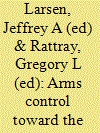

|
|
|
|
|
| Publication |
Boulder, Lynne Rienner, 1996.
|
| Description |
xx, 347p.
|
| Standard Number |
1555875610
|
|
|
|
|
|
|
|
|
|
|
|
Copies: C:1/I:0,R:0,Q:0
Circulation
| Accession# | Call# | Current Location | Status | Policy | Location |
| 040948 | 327.174/LAR 040948 | Main | On Shelf | General | |
|
|
|
|
| 2 |
ID:
153892
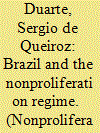

|
|
|
|
|
| Summary/Abstract |
This article addresses the historical relations between Brazil and the international nonproliferation regime. It also discusses the current position of the Brazilian government regarding the Additional Protocol and the Treaty on the Non-Proliferation of Nuclear Weapons, as well as some aspects of the Brazilian nuclear program.
|
|
|
|
|
|
|
|
|
|
|
|
|
|
|
|
| 3 |
ID:
156591
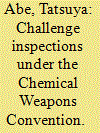

|
|
|
|
|
| Summary/Abstract |
The challenge-inspection system under the 1997 Chemical Weapons Convention has been regarded as an “epoch-making” procedure. Any state party can request a challenge inspection “anytime, anywhere, without right of refusal.” Yet, despite its high value in theory, no challenge inspection has yet been requested. There are legal, political, and other reasons that account for the absence of any such request. However, in the context of Syria's chemical weapons, several ad hoc measures have been taken that could be considered alternative to the challenge-inspection system. These developments have implications, largely negative, for that system. It is likely that ad hoc alternative measures will be employed in the future, though their use will depend on the situation. Although the challenge-inspection system may not be employed in the future, its theoretical availability remains and contributes to the prevention of noncompliance to a certain extent.
|
|
|
|
|
|
|
|
|
|
|
|
|
|
|
|
| 4 |
ID:
187496


|
|
|
|
|
| Summary/Abstract |
Arms control has increasingly become threatened by compliance issues. Viewed individually, these issues might be expected and should not be cause for alarm. However, the list of agreements with unresolved issues has grown too long to ignore. The US State Department’s 2021 arms-control-compliance report calls attention to this problem. Recent casualties include the 1987 Intermediate-Range Nuclear Forces Treaty, the 1990 Conventional Armed Forces in Europe Treaty, and the 1992 Open Skies Treaty. Although the 2010 New Strategic Arms Reduction Treaty has been renewed, even the 1968 Treaty on the Non-Proliferation of Nuclear Weapons is under stress because of the view, shared by many states, that there has been a failure to implement its key nuclear-disarmament obligation. Many are advocating a move to less formal arms-control arrangements that are politically but not legally binding. However, these bring their own set of compliance problems—in particular, lack of effective verification regimes and dispute-resolution mechanisms. The current approach to compliance issues is failing. These issues need more urgent, high-level attention if the world is to avoid this threat to international peace and security.
|
|
|
|
|
|
|
|
|
|
|
|
|
|
|
|
| 5 |
ID:
182966


|
|
|
|
|
| Summary/Abstract |
The 1993 Chemical Weapons Convention (CWC) and the 1972 Biological and Toxin Weapons Convention (BWC) are key components of the international arms-control landscape. Yet the two conventions differ widely, particularly in the ways that are available to treaty parties to resolve any questions about compliance with the treaties. Both contain language concerning consultation and cooperation, but the CWC also has extensive procedures available to investigate allegations of noncompliance. This article reviews these differences in the conventions and explains, in part, how and why they came about. The Organisation for the Prohibition of Chemical Weapons (OPCW) has engaged in several consultations regarding compliance issues, but the OPCW publishes virtually nothing about the topics of the consultations or their frequency, findings, or conclusions. An exception, perhaps, is the OPCW’s work regarding Syrian use of chemical weapons (CW). Moreover, thus far, no treaty party has called for a challenge inspection to officially investigate perhaps the most serious allegations of treaty violations: Syrian and Russian alleged use of CW. The BWC states parties conducted one formal consultation raised by Cuba, alleging that the United States dropped biological agents on the island nation from airplanes to cause an animal epidemic. The consultation reached no official conclusion. The article goes on to praise the work of Raymond Zilinskas debunking the allegations through a careful scientific review of the Cuban claims. The article discusses the consequences of secrecy surrounding the CWC consultation process and laments that the BWC does not have the institutional capacity to carry on the type of analysis that Zilinskas undertook discrediting the Cuban allegations.
|
|
|
|
|
|
|
|
|
|
|
|
|
|
|
|
| 6 |
ID:
152057
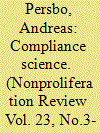

|
|
|
|
|
| Summary/Abstract |
The Comprehensive Nuclear-Test-Ban Treaty's verification regime is arguably one of the most effective and efficient systems of arms-control and disarmament monitoring in operation today. The science and technology underpinning the system have been developed over several decades. This article goes through the treaty's international monitoring system and pays particular attention to its waveform-monitoring techniques. It then considers the concept of data fusion, before describing the agreement's on-site-inspection mechanism. It briefly discusses how alleged noncompliance is likely to be resolved. It concludes by arguing that the treaty's verification regime is expected to make cheating costly, which enhances the treaty's deterrent effect.
|
|
|
|
|
|
|
|
|
|
|
|
|
|
|
|
| 7 |
ID:
127633
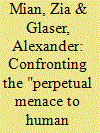

|
|
|
|
|
| Publication |
2014.
|
| Summary/Abstract |
Nuclear weapon states historically have attached great secrecy to their nuclear weapon and fissile material production programs and stockpiles, despite warnings that this would fuel fears, handicap informed debate and decision making, and drive arms races. As evidenced by the "Action Plan on Nuclear Disarmament" agreed upon at the 2010 Treaty on the Non-Proliferation of Nuclear Weapons (NPT) Review Conference, however, the international community now sees greater transparency about nuclear weapon and fissile material stocks as necessary for enabling and monitoring progress toward nuclear disarmament. To support this effort, the International Panel on Fissile Materials has proposed a step-by-step program for weapon states to declare their inventories, production histories, and disposition of nuclear warheads and fissile materials, and to set up joint projects to develop methods for verifying these declarations. This openness initiative is described here, and could be adopted at the 2015 NPT Review Conference, laying a basis for negotiating verifiable deep reductions in nuclear arsenals and their eventual elimination.
|
|
|
|
|
|
|
|
|
|
|
|
|
|
|
|
| 8 |
ID:
171181


|
|
|
|
|
| Summary/Abstract |
Novichok agents are a class of nerve agents developed by the Soviet Union during the Cold War. In light of the use of a Novichok agent in Salisbury in March 2018, two sets of proposals to amend Schedule 1 of the 1993 Chemical Weapons Convention (CWC) have been put forth, one jointly by the United States, Canada, and the Netherlands, and the other by Russia. Both sets of proposals will be discussed and voted upon at the next Conference of States Parties of the Organisation for the Prohibition of Chemical Weapons (OPCW) in November 2019. If either set of proposals is approved, it will be the first time that the list of chemicals subject to verification under the CWC will have been modified. This viewpoint will discuss these proposals, and argue that, if adopted, the joint proposal and the portions of the Russian proposal upon which consensus can be reached would significantly strengthen the CWC by considerably expanding the coverage of its Schedule 1 and bringing Novichok agents firmly within the CWC’s verification system. We also argue that, since the OPCW Technical Secretariat did not deem the fifth group of chemicals proposed by Russia to meet the criteria for inclusion in Schedule 1, Russia should withdraw this part of its proposal from consideration. The proposals have also served an important purpose in clarifying the identity of the chemical agent used in the Salisbury incident, squarely placing it within one of the two families of Novichok agents described by the Russian chemical-weapons scientist and whistleblower Vil Mirzayanov. If either proposal is approved in November, it will be important to conduct a thorough assessment of key precursors for the synthesis of Novichok agents and assess the need to amend CWC schedules and national and multinational export-control lists accordingly.
|
|
|
|
|
|
|
|
|
|
|
|
|
|
|
|
| 9 |
ID:
123692


|
|
|
|
|
| Publication |
2013.
|
| Summary/Abstract |
AbstractThis article examines negotiations expected to be conducted during actual implementation after entry-into-force of the Comprehensive Nuclear-Test-Ban Treaty (CTBT). It analyzes the negotiations to be undertaken with regards to on-site inspection (OSI) procedures, and their unique character as post-agreement negotiations (PAN) is identified. In particular, the OSI negotiations will be conducted at the Executive Council (EC) level and will analyze whether violations of the treaty have occurred. This discussion further explores another level of negotiation that will occur during the OSI, between the inspected state and the inspection team, concerning the technical details of implementation. Our analysis demonstrates how these inspection negotiations will likely have an impact, well beyond the OSI itself, on the PAN in the EC regarding OSI, and further on PAN in policymaking organs, and thus on regime evolution.
|
|
|
|
|
|
|
|
|
|
|
|
|
|
|
|
| 10 |
ID:
152059


|
|
|
|
|
| Summary/Abstract |
Twenty years after the establishment of the Preparatory Commission charged with setting up the Comprehensive Nuclear-Test-Ban Treaty Organization, the CTBT is still not in force. Nevertheless, based on the legal instruments adopted in 1996 by the state signatories, the commission has standing as a full-fledged international organization with the legal capacity needed for the exercise of its functions and the fulfillment of its purposes. Moreover, the verification technologies developed by the organization have triggered manifold effects, particularly for disaster warning and response. Irrespective of CTBT entry into force, the commission is playing a relevant role in monitoring nuclear testing as well as in delivering the benefits of verification technologies to the international community.
|
|
|
|
|
|
|
|
|
|
|
|
|
|
|
|
| 11 |
ID:
169455


|
|
|
|
|
| Summary/Abstract |
Nuclear disarmament is often seen as eventually requiring access to nuclear warheads or to the warhead-dismantlement process to verify that a state has not hidden weapons or weapon-materials despite promising to disarm. This article suggests this view is misplaced, and that what is needed is a verification mechanism able to provide reliable assurances of the absence of fissile materials available for use in weapons after a state has disarmed. Such a mechanism will need an initial declaration of the amount of fissile materials held by a state for all purposes, military and civilian. In a state with a nuclear arsenal awaiting elimination, this declaration would have to include materials that may not be available for verification because they are in nuclear weapons or are in other classified or proliferation-sensitive forms. This article describes a verification arrangement that does not require access to materials in weapons and in sensitive forms while still allowing checks on the overall accuracy of the declaration. Verification of the completeness and correctness of the declaration is deferred to the time when the weapons-relevant material enters the disposition process, at which point it no longer has any sensitive attributes. By removing the focus on monitoring warheads and dismantlement, this new approach could provide a more manageable path to nuclear disarmament.
|
|
|
|
|
|
|
|
|
|
|
|
|
|
|
|
| 12 |
ID:
169456


|
|
|
|
|
| Summary/Abstract |
Researchers have recently proposed a new approach to nuclear-arms-control verification, dubbed “deferred verification.” The concept forgoes inspections at sensitive nuclear sites and of nuclear weapons or components in classified form. To implement this concept, a state first divides its nuclear program into a closed segment and an open segment. The total fissile-material inventory in the closed segment, which includes the weapon complex, is known and declared with very high accuracy. Essentially no inspections take place in the closed segment. In contrast, inspectors have access to the open segment, which includes in particular the civilian nuclear sector. The fissile-material inventory in the open segment is known with less accuracy, but uncertainties can be reduced over time using nuclear-archaeology methods. Deferred verification relies primarily on established safeguards techniques and avoids many unresolved verification challenges, such as the need for information barriers for warhead confirmation measurements. At the same time, deferred verification faces some unique challenges. Here, we explore some of these challenges and offer possible solutions; to do so, we examine possible noncompliance strategies in which a state would seek to withhold a higher-than-declared inventory.
|
|
|
|
|
|
|
|
|
|
|
|
|
|
|
|
| 13 |
ID:
182970
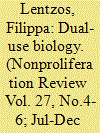

|
|
|
|
|
| Summary/Abstract |
At a time of heightened concern about potential future biological-weapons threats, this article considers how the international community can use the Biological and Toxin Weapons Convention framework to strengthen compliance monitoring of rapidly increasing dual-use capacities around the globe. It presents three conceptual layers within the treaty regime which states can draw from to inform their compliance judgments: one legally binding, one politically binding, and one wholly voluntary. The article outlines how these were established and how they have been used so far, and argues for an incremental, inclusive, practical, and forward-looking approach to evolving these structures to better manage perceptions of the intent behind dual-use capacities, and to further trust between states.
|
|
|
|
|
|
|
|
|
|
|
|
|
|
|
|
| 14 |
ID:
181691
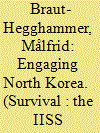

|
|
|
|
|
| Summary/Abstract |
North Korea and the United States are edging towards re-engagement. They agree in principle on pursuing a phased approach to negotiations but disagree on how to begin and what the end goal should be. A warming-up phase can allow states to informally explore specific options for future engagement. By participating in activities such as table-top exercises, simulations and familiarisation visits, the participants develop a more specific understanding of the purpose and format of the activities and verification measures that might follow a formal agreement. This process engages the technical and military bureaucracies at an early stage. It provides a private setting to raise concerns and address misunderstandings. It is an opportunity to demonstrate goodwill and interest in engagement that does not require concessions. Drawing on past examples, this article suggests specific options for a warming-up phase involving North Korea and the United States.
|
|
|
|
|
|
|
|
|
|
|
|
|
|
|
|
| 15 |
ID:
107567
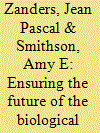

|
|
|
|
|
| Publication |
2011.
|
| Summary/Abstract |
This introductory article first provides an overview of key historical developments pertaining to the Biological Weapons Convention (BWC), exposing the roots of the assertion that the treaty is unverifiable. The article also reviews the factors that have changed since the BWC's negotiation, including those that loom over the BWC's effective implementation today, with special emphasis on the challenges posed by the advancement and global diffusion of life sciences know-how, technologies, equipment, and capabilities. The narrative concludes with a description of the methodology behind this special issue of the Nonproliferation Review, introducing the contributing authors and the common questions they address in the context of their topics.
|
|
|
|
|
|
|
|
|
|
|
|
|
|
|
|
| 16 |
ID:
073396
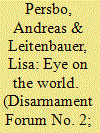

|
|
|
| 17 |
ID:
111133
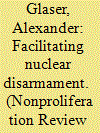

|
|
|
|
|
| Publication |
2012.
|
| Summary/Abstract |
Unprecedented interest in seeking progress toward nuclear disarmament exists today; even some nuclear weapon states are looking for new ways to strengthen this process. National declarations of fissile material holdings-highly enriched uranium and plutonium-could play an important role in supporting this effort, facilitating not only transparency but also the irreversibility of the process. This article discusses what kind of content such declarations could have in order to be meaningful and effective, the sequence of data on fissile material holdings that states might release, and some of the challenges to be expected in reconstructing historic fissile material production; it also summarizes current attitudes of weapon states toward making such declarations. Initial declarations can be valuable as confidence-building measures, but better and more background data are necessary if declarations are to serve as the groundwork for deeper cuts in the nuclear arsenals. A robust verification approach would ultimately require inspectors to have access to fissile material production and storage sites. The methods and tools of nuclear forensic analysis-in this context also dubbed nuclear archaeology-would be a key element of this process. This article discusses the capabilities and limitations of potential approaches to verifying declarations of historic production of plutonium and highly enriched uranium; it also identifies and discusses opportunities for further research and development.
|
|
|
|
|
|
|
|
|
|
|
|
|
|
|
|
| 18 |
ID:
152055
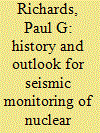

|
|
|
|
|
| Summary/Abstract |
Modern methods of nuclear-explosion monitoring are vastly more capable than they were when underground nuclear testing began in the late 1950s, in part because a cycle of improvements in explosion monitoring in the 1960–80 period led to improvements in monitoring for earthquakes and other phenomena, which then led to a general growth in monitoring assets that in turn has been applied back to explosion monitoring. Practical experiences in nuclear-explosion monitoring, acquired during the era of active testing prior to finalization of the CTBT text in 1996, laid the basis for monitoring in support of this arms-control initiative. This article elaborates on the future of nuclear-test-monitoring technology, which can build upon an additional and remarkable growth of general monitoring assets that began in the 1990s, largely unrelated to the specifics of nuclear-test monitoring. A new cycle of improvements in earthquake monitoring is likely to improve monitoring for explosions. While it is not easy to quantify the degree of monitoring improvement afforded by such new assets, an example from North Korea indicates the improvement can be substantial.
|
|
|
|
|
|
|
|
|
|
|
|
|
|
|
|
| 19 |
ID:
182647


|
|
|
|
|
| Summary/Abstract |
This article provides an inside view of the sustained effort by the Group of Scientific Experts (GSE) which was key to the development of the international seismic network included in the 1996 Comprehensive Nuclear-Test-Ban Treaty (CTBT). Over the course of the GSE’s twenty-year-long journey, part of which was at the height of the Cold War, the GSE went from being a little-known entity that reviewed and encouraged research to designing and testing elements of a seismic verification system. Their work eventually included full-scale testing of the seismological component of the final global system that is now implemented by the Preparatory Commission of the CTBT Organization. The other three monitoring networks comprised in the treaty—radionuclide, hydroacoustic, and infrasound—are modeled after the seismic network. The article identifies some key conditions that made GSE a successful endeavor. Prime among these was the strong engagement among scientists and scientific institutions in many countries that contributed large resources. The formal work at the Conference on Disarmament in Geneva was just the tip of the iceberg, but very important. This official intergovernmental framework provided a connection to the political community, and a frame for organizing extensive global development and testing activities. GSE was given long-term mandates and self-determination of management and leadership, facilitating a sustained and goal-oriented process. Based on their leadership experience in the GSE and the CTBTO Preparatory Commission Verification Working Group, the authors also provide some reflections on how the concept of scientific expert groups and new scientific developments could prove useful in future efforts toward nuclear-disarmament verification.
|
|
|
|
|
|
|
|
|
|
|
|
|
|
|
|
| 20 |
ID:
099515
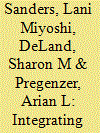

|
|
|
|
|
| Publication |
2010.
|
| Summary/Abstract |
In his 2009 Prague speech and the 2010 Nuclear Posture Review, President Barack Obama committed the United States to take concrete steps toward nuclear disarmament while maintaining a safe, secure, and effective nuclear deterrent. There is an inherent tension between these two goals that is best addressed through improved integration of nuclear weapons objectives with nuclear arms control objectives. This article reviews historical examples of the interaction between the two sets of objectives, develops a framework for analyzing opportunities for future integration, and suggests specific ideas that could benefit the nuclear weapons enterprise as it undergoes transformation and that could make the future enterprise compatible with a variety of arms control futures.
|
|
|
|
|
|
|
|
|
|
|
|
|
|
|
|
|
|
|
|
|